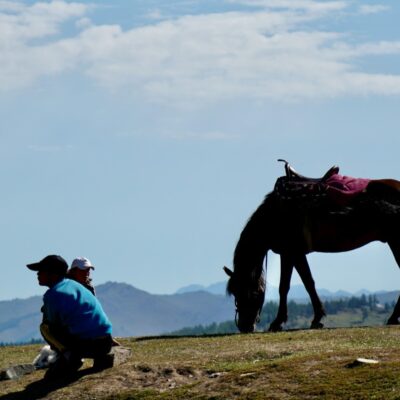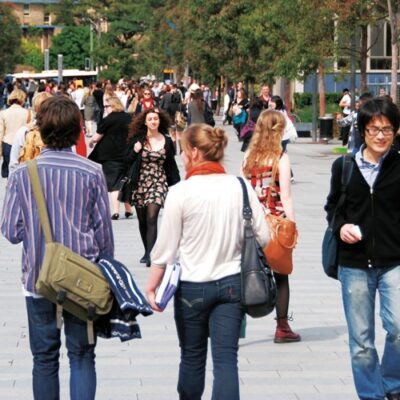Chinese language proficiency has been regarded as essential for Australia’s prosperity for the past three decades, and various policies and initiatives have been implemented to equip the population with such language capacity. The National Asian Languages and Studies in Australian Schools (NALSAS) program (1995-2002) and National Asian Languages and Studies in Schools Program (NALSSP, 2008-2012) identified Chinese as a priority language and provided financial support for its teaching and learning, while the Australia in the Asian Century White Paper (2012) also labelled Chinese a priority language in addition to recommending that businesspeople and public servants gain experience and knowledge of Asia. Most recently, the New Columbo Plan (NCP, 2014-present) provides funding for students to undertake study and internships in China (PRC) and other Asian countries.
Despite this decades long effort, multiple reports (e.g. Maximizing Australia’s Asia knowledge: Repositioning and renewal of a national asset [2002, Asian Studies Association of Australia], Building Chinese language capacity in Australia [2016, Australia-China Relations Institute], Australia’s Asia education imperative [2022, Asian Studies Association of Australia], Australia’s China knowledge capability [2023, Australian Academy of the Humanities]), have revealed that Australia’s Chinese language capacity remains low. These reports highlight that additional financial support from state and federal governments, increased coordination of Chinese language courses at the national level, improved teacher training and more opportunities for in-country studies and experiences for students are required to achieve extensive Chinese language proficiency in Australian society. Federal governments of both major parties continue to emphasise the importance of Asia, and China (PRC) in particular, to Australia, yet have not committed the necessary financial and other resources that such reports deem necessary for the development of Chinese language proficiency.
Universities and schools have been able to compensate to some extent by accessing resources through Confucius Institutes (CIs) and Confucius Classrooms (CCs) respectively, which provide teaching materials, teaching staff and other kinds of support for Chinese language and culture education. However, CIs and CCs have become suspect and less desirable along with complex relations between Australia and China.
Recently, an alternative source of support for Chinese language education has emerged—the Taiwan Centre for Mandarin Learning (TCML), launched by Taiwan’s government in 2021. To date, 68 TCMLs have been established in the USA and 20 in Europe. According to a report in the Taipei Times, some Australian universities have expressed interest in cooperating with the TCMLs, while a report in the Taiwan News says that the Taiwanese government has raised the idea of establishing TCMLs with the Australian government.
The TCML has been analysed from the perspective of language policy and soft power. These studies reveal that the purpose of the TCML is to increase Taiwan’s international profile by distinguishing it from the PRC. The framing and promotion of the TCML focus on Taiwan’s democratic and open society and sees Chinese language teaching as a means of communicating these characteristics to the world.
However, no studies have examined the possibilities and implications of the TCML to support Chinese language education in Australia. This paper asks how the TCML could be incorporated into Australia’s language education to support the development of Chinese language proficiency.
Confucius Institutes and Confucius Classrooms in Australia
A Confucius Institute is a language and culture centre established cooperatively between a Chinese university and a foreign university and funded by the Chinese (PRC) government. A Confucius Classroom is the counterpart of the CI in primary and secondary schools in Australia. Until mid-2020, CIs and CCs were coordinated by the Office of Chinese Language Council International, known as Hanban, an organisation under the Ministry of Education in China. They are currently handled through the Chinese International Education Foundation, a non-governmental organisation consisting of resources and support from universities and industry partners. CIs are housed on Australian university campuses and host universities provide a local director, office space and other in-kind resources. The Chinese partner universities provide teaching staff and a co-director to assist with operations. CCs are likewise housed in schools and are usually connected to a CI which provides support for and coordination of their activities.
The first Australian CI opened at the University of Western Australia in 2005. In the ensuing years, a total of 14 CIs and 67 CCs were established, at one time the third highest number of CIs and CCs for a single country after the USA and UK. CIs and CCs were welcomed by Australian universities and schools as a means of enhancing Chinese language education and facilitating connections to China. This was especially the case under the Labor government (2007-2013) when there was a general optimism about Australia-China relations despite some difficulties in the relationship, such as China’s reaction to the Australian government’s Defence White Paper, Rino Tinto’s cancelation of a deal with state-owned enterprise Chinalco and the Australian government’s decision to grant a visa to Uyghur World Congress president Rebiya Kadeer. During this period, some academics, journalists, politicians and members of the public raised concerns that CIs would restrict academic freedom, disseminate pro-Chinese government views and be used as platforms for espionage. However, no action was taken to close CIs or CCs.
Such concerns intensified as Australia-China relations deteriorated under the Coalition government between 2018 and 2022, following a series of political decisions—not least its 2018 ban on Chinese telecommunication companies Huawei and ZTE from constructing the country’s 5G network, and the 2020 call for an independent investigation into the origins of the COVID-19 pandemic. These foreign policy moves led to China’s subsequent trade sanctions on a range of Australian goods, including barley, beef, coal, timber, lobsters and wine, among others. While diplomatic relations between Australia and China became increasingly strained, the operations of CIs and CCs were also affected. In 2018, the New South Wales (NSW) state government reviewed and later closed the CI in the NSW Department of Education and the 13 CCs it coordinated.
This hardening of views on CIs and CCs continued with the introduction of the Australia’s Foreign Relations (State and Territory Arrangements) Act in 2020. Designed to ‘protect and manage Australia’s foreign relations’, the Act examined foreign interference in universities, including CIs. Following this, the Parliamentary Joint Committee on Intelligence and Security’s report, Inquiry into national security risks affecting the Australian higher education and research sector, made several recommendations regarding CIs. These included that universities make their CI agreements publicly available and maintain control over all aspects of the CIs’ operations, and that the Foreign Minister exercise veto powers over any CI agreement considered contrary to Australia’s national interest. Concerns over the role of CIs and CCs in Australia’s Chinese language education continue, as revealed in a study of educators’ perspectives on the impact of Australia-China relations on Chinese language and China Studies in Australian universities and schools, and a study of media and teacher discourses surrounding Chinese language education in Australia. In this environment, further closures have occurred. The CI at RMIT was closed in 2021, amidst the COVID-19 pandemic. Four other Australian universities (University of Melbourne, University of Queensland, University of New South Wales, University of Western Australia) have decided not to renew the contracts for their CIs, while the CI at the University of Adelaide has been inactive for some time, and the Queensland University of Technology is set to review its CI next year.
The Taiwan Centre for Mandarin Learning: Background and development
TCMLs are language and culture education centres established in cooperation with Taiwan’s overseas compatriot schools. They are coordinated by Taiwan’s Overseas Community Affairs Council (OCAC), a cabinet-level government agency. Compatriot schools apply to the OCAC to establish a TCML, and if approved, the OCAC provides ‘funding, materials, teaching resources, personnel training, promotion, and marketing’, while overseas compatriot schools supply ‘teaching venues, equipment, and teachers’. Each TCML is assessed annually by the OCAC.
TCMLs conduct Chinese language teaching, language proficiency testing and cultural activities targeted at adult learners in host countries. Their classes generally follow three textbooks recommended by the OCAC, Speak Mandarin in 500 Words, Speak Mandarin in 1000 Words and Let’s Learn Mandarin, although there is some scope for TCMLs to use and develop their own materials. In terms of language proficiency testing, TCMLs administer the Test of Chinese as a Foreign Language (TOCFL), developed by the Taiwanese Ministry of Education. Both language teaching and testing use traditional characters. Cultural activities include dance, music, calligraphy, cooking, martial arts and traditional art lessons.
The initiation of the TCML project was prompted partly by the Taiwanese government’s perception of widespread demand for Chinese language learning, as outlined by the OCAC:
‘Mandarin learning fever’ is an important phenomenon in international society and there is ever increasing demand for Mandarin learning across the world, with the number of learners increasing all the time and governments attaching increasing importance to Mandarin education. […] With Mandarin learning fever spreading around the world, Taiwan’s excellent Mandarin education will have more space for promotion around the world, consequently, the Overseas Community Affairs Council (OCAC) has put forward the Taiwan Center for Mandarin Learning program.
In addition, Taiwan and the USA signed a Memorandum of Understanding (MoU) on international education cooperation under the Taiwan-US Education Initiative in 2020. This MoU aims to create and enhance cooperation on English and Chinese language education, especially as views towards China’s CIs and CCs have hardened in the USA.
It is in this sense that the TCMLs have been envisioned as an alternative to the CIs. They appear to have gained some traction internationally, specifically in the USA and Europe, with 18 established in 2021, 25 in 2022 and 26 applications approved in 2023. Taiwan’s government has identified Australia as a potential location for more TCMLs. Wang Ting-yu, a member of the Legislative Yuan’s Foreign Affairs and Defence Committee, proposed establishing TCMLs in Australia, as did fellow member Chao Tien-lin (in addition to New Zealand and Canada). The Minister of the OCAC, Hsu Chia-ching, also said Australia could be included in the next four-year budget for establishing TCMLs, commencing in 2026. Given Australia’s desire to build Chinese language capacity, how could TCMLs be incorporated into the country’s language-in-education policy?
Considerations
Based on experiences with CIs, we outline what Australian universities and Australian federal and state governments would need to consider if they were to establish TCMLs.
Practical and Organisational Issues
Thus far, TCMLs have not been established at universities, meaning there is no model for this to occur. In principle, the same model as used for compatriot schools could be used with universities. However, studies of CIs have identified a range of practical and organisational issues including contractual obligations, hiring practices, course content and the relationship between CIs and existing Chinese language and studies programs, associated with hosting a CI. These would apply to the TCML, especially as they have not been set up at universities to date.
In addition, the TCML has its own political overtones. TCML teachers, according to the OCAC, ‘must not hold passports from Mainland China, Hong Kong or Macau’, and TCMLs are required to ‘prioritise [the employment of] teachers who hold nationality of the Republic of China [Taiwan] or are from Taiwan’. These requirements mean that universities still need to accept the political interests of a foreign government.
Teaching Content
TCMLs teach standard Mandarin as it is spoken in Taiwan (Guoyu, literally national language) and traditional Chinese characters. This contrasts with the standard practice at Australian universities of teaching Modern Standard Chinese (Putonghua, literally common language, referring to a standard spoken form of Mandarin) and simplified characters as used in China (PRC).
The Australian school curriculum also mandates Modern Standard Chinese, simplified characters and the pinyin romanisation system, although the varieties of Mandarin Chinese, including traditional characters and unique cultural aspects in different Chinese speaking cultures (e.g., Taiwan, China, Singapore and some parts of Malaysia) are introduced and discussed to foster students’ (inter)cultural competence. School leavers would then experience a disconnect between their Chinese language learning at school and at a TCML, which is not conducive to obtaining proficiency. Similarly, those enrolled in university courses, where Modern Standard Chinese is taught, would likely face the additional challenge of learning traditional characters as required by TCMLs.
Political Implications for Australia-China Relations
CIs have been a source of tension in the Australia-China relationship. China denounced the closure of the NSW Department of Education CI and associated CCs as damaging relations between Australia and China. For example, the Confucius Institute Headquarters said, ‘We hope the NSW government will give more consideration to the negative influence of closing the Confucius program [sic] on the state’s Chinese language education and its education cooperation with China’, while then Foreign Ministry spokesman Geng Shuang said, ‘We hope the Australian side will respect their Chinese partner and do more things to strengthen mutual trust’.
The TCML has received a similar reaction from China. Chinese media outlets such as Global Times, Sohu and Tencent have run stories critical of the TCML, and characterised them as an attempt to contain China. Furthermore, setting up TCMLs in Australia would create a situation where Taiwan has its own language and culture promotion body operating in parallel to China’s CIs and CCs. This will challenge China as the sole authentic representative of Chinese language and culture—an action that China would likely rebuke as it regards Taiwan as a breakaway province and attempts to curtail its international presence. It is therefore likely that the establishment of TCMLs in Australia would draw criticism from China, potentially provoking political and economic retaliation—such as the downgrading or suspension of diplomatic engagement and/or the imposition of trade sanctions—especially at a time when cross-strait tensions are rising, with China intensifying its military and economic pressure on Taiwan following the re-election of the Democratic Progressive Party (DPP).
Policy recommendations
Australian universities and Australian federal and state governments should not shy away from opportunities that could potentially help enhance the country’s Chinese language capacity. They should welcome such resources with a pragmatic and balanced approach to decreasing the risk of causing unnecessary conflict with China and interfering with Taiwan-China geopolitical rivalry. To this end, based on the considerations discussed above, we make several recommendations for how TCMLs could be used.
The basis of our recommendations is that the running of TCMLs should be driven by cooperation between Chinese language teachers at Taiwanese compatriot schools in Australia and Chinese Studies academics and researchers in Australian universities, while both the Taiwanese and Australian governments minimise their presence and intervention in this process. Although the Australian government’s approval of such an educational initiative could be interpreted as geopolitical alignment with other democracies—suggesting the decision is not entirely neutral—an arm’s length approach by both governments in the operation of TCMLs would highlight the role of non-state actors in facilitating cultural interaction and learning between peoples. This approach would reduce the likelihood of working with TCMLs being perceived as politically oriented and directly counteractive towards China’s CIs. Our recommendations highlight the importance of people-to-people engagement and sociocultural exchanges, which have been shown to produce benefits for Australian people and society in other areas such as academic cooperation, Indigenous peoples art exchange and arts programs.
Recommendation 1: TCMLs as supplementary to existing programs
TCMLs should not replace existing Chinese language programs at Australian universities. Instead, they should be used to provide additional or extended learning for students who are already familiar with Chinese, and who want to learn traditional characters and learn about Taiwan. This can include providing support and funding mechanisms for university students to have Taiwan in-country experience or hybrid (in-person and online) learning opportunities through TCMLs.
Recommendation 2: TCMLs as separate from university campuses
To avoid the practical and organisational issues associated with CIs, TCMLs should be set up as self-standing entities away from university campuses. Other language and culture promotion organisations, such as the Alliance Française and Goethe Institute, operate on this model. They have been established as physically independent organisations, in contrast to CIs, which are typically embedded within foreign tertiary education institutions. According to a recent study on China’s cultural diplomacy in Australia, this model is perceived as less controversial, as it follows ‘a structure which Australia was already familiar with because it had been done by other countries’, as noted by a former Australian cultural diplomat. Locating TCMLs away from university campuses would also signal that they do not have official endorsement from universities, which in turn could reduce the potential of a political reaction from China.
Recommendation 3: TCMLs for specific Chinese language and culture projects
Universities can collaborate with TCMLs to deliver specific courses and activities that students need. This can be done through integrating unique language and culture dimensions related to Taiwanese society and lifestyle into the university program. The program and course coordinators may take the opportunity to co-design and co-plan specific units and projects with the support of TCMLs to navigate the diversity of Mandarin and its associated cultures by drawing on all possible Chinese speaking cultures.
Conclusion
Creating and improving Chinese language capacity remains an important policy goal for Australia, despite its complex relationship with China. On face value, the TCML appears to be in line with this goal. However, as shown in this paper, incorporating the TCML into Australia’s Chinese language education raises a number of issues, from the practicalities of language teaching and learning to its broader political implications. Australian universities and federal and state governments will need to think carefully and strategically about how they could use them, especially in the context of navigating Australia’s relationships with China and Taiwan. The recommendations made here aim to guide this process.
Authors: Dr Jeffrey Gil, Dr Minglei Wang & Dr Grace Yue Qi
Image: Weitian Temple 桃園威天宮, Taoyuan, Taiwan 2022. Credit: Jirka Matousek/Flickr.




